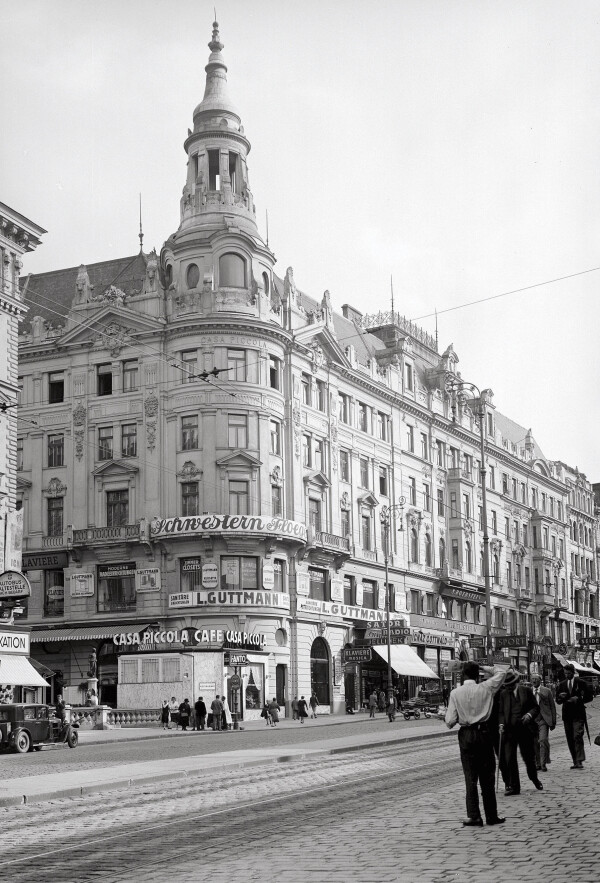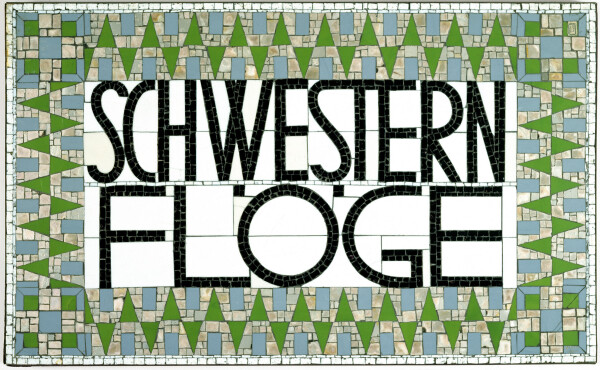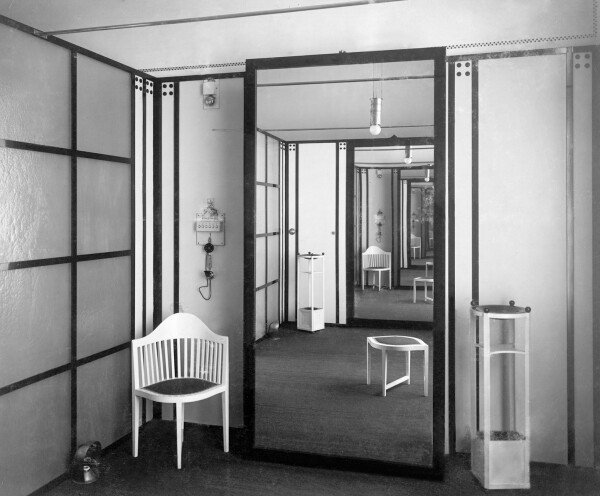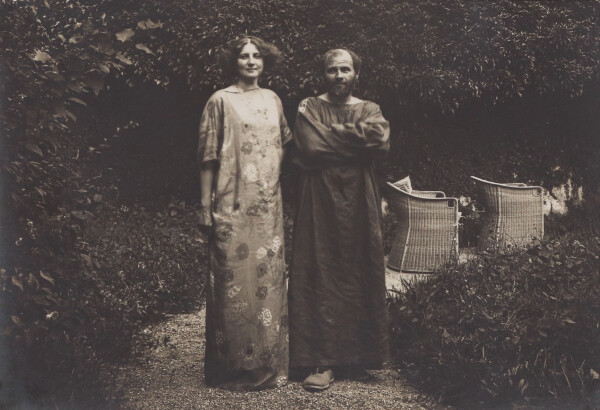The Schwestern Flöge Fashion Salon

House "Casa Piccola" in Vienna's Mariahilfer Straße, view around 1930
© Klimt Foundation, Vienna

Business sign for the "Schwestern Flöge" fashion salon, 1904
© MAK

Trial rooms in the "Schwestern Flöge" fashion salon, 1904
© MAK

Emilie Flöge and Gustav Klimt in the garden of Villa Oleander, summer 1910, Klimt Foundation
© Klimt Foundation, Vienna
The Flöge sisters’ fashion salon – a Gesamtkunstwerk by the Wiener Werkstätte – held a unique position in the fin de siècle. The enterprise was run by three emancipated women who were in close contact with Gustav Klimt and shaped the world of fashion in Vienna.
The Schwestern Flöge Fashion Salon’s Corporate Identity
On 1 July 1904, the sisters Emilie, Pauline, and Helene opened their fashion salon “Schwestern Flöge” on the second floor of a building referred to as Casa Piccola at Mariahilfer Straße 1b in Vienna. By then the building, which had been refurbished toward the end of the 19th century, also accommodated their private apartment. The name goes back to Dominik Casapiccola, the owner of the coffeehouse originally located there.
The Wiener Werkstätte, which had been founded in 1903, was entrusted with the interior decoration of the new fashion salon. Josef Hoffmann and Kolo Moser designed furnishings for the shop that stood out for their simplicity and geometric style. The two artists were also responsible for all sorts of printed matter, wallpapers, and textile labels, thus creating the company’s corporate identity in the sense of a Gesamtkunstwerk or universal work of art. Articles published in the Viennese art magazine Hohe Warte in 1904 and in the periodical Deutsche Kunst und Dekoration the following year offered glimpses of the rooms.
The Flöge Sisters’ Entrepreneurial Spirit
Although little is known about the fashion salon’s beginnings and how it was funded, the allocation of tasks within the company was clear from the very outset. Emilie was in charge of everything that had to do with art and fashion. Helene Klimt (née Flöge), Ernst Klimt’s widow, attended to the customers. Pauline was responsible for the workshop and bookkeeping. After her death in 1917, Helene Donner (née Klimt), Helene and Ernst Klimt’s daughter, took over.
The salon’s customers were art- and fashion-minded ladies from the Viennese upper classes. Many of them were in direct contact with Klimt and the Wiener Werkstätte in their roles as patronesses and sitters for portraits. Sonja Knips, Hermine Gallia, Eugenia Primavesi, Clarisse Rothschild, and several female members of the Lederer family had themselves robed and outfitted by the Flöge sisters.
The Flöge Sisters’ Fashion
The sisters’ chief source of inspiration for their creations was 19th-century German reform fashion. Its goal was to grant women more ease of movement. But the spectrum of Flöge designs went far beyond, ranging from light-colored summer dresses with wide skirts, extravagant patterns, and corseted waists to diverse interpretations of the “reform dress.” When she sojourned on the Attersee, Emilie Flöge liked wearing her own creations, preferring wide, kaftan-like garments in these surroundings that stood out for their fabrics in different colors and expressive patterns. Her plain “Bat Dress,” featuring a pattern of black and white stripes, became famous. Both in her private environment and on official occasions, Emilie Flöge’s sense of fashion was beyond question. For the opening of the “Kunstschau Wien 1908,” she wore a wide black and white striped dress with flamboyant flounces anticipating the Neo-Empire style.
Klimt’s Affinity for Fashion
Gustav Klimt also contributed to the fashion salon’s corporate identity by supplying the design for the signet. Moreover, in the summer of 1906 he photographed Emilie in several of her designs. Ten of these photographs were subsequently published in the periodical Deutsche Kunst und Dekoration. That her closeness to Klimt was in turn essential and inspirational for Flöge even beyond his death is illustrated by the fact that she had a special “Klimt Room” installed in the fashion salon in commemoration of her companion, who had played such an important role in her life.
Klimt was generally interested in fashion, as correspondence between Flöge and him reveals. A keen observer, he wrote to her during his stay in Paris in 1909:
“[H]ere you can take all the chances you want with your costume without attracting attention. You would have a great time here.”
Klimt himself frequently wore suits, but in his studios in Vienna and on the Attersee he donned a special piece of clothing: a caftan-like painter’s smock in indigo blue. It seems that the artist starting wearing this garment in diverse variants identifiable by the patterns of the shoulder decorations around the time the fashion salon was founded. Its design very likely also comes from the circle of Emilie Flöge.
The Relics of the Schwestern Flöge Fashion Salon
Starting in the 1920s, the Flöge sisters’ fashion salon saw a decline in business. Helene Klimt, Emilie’s sister, died in 1936. In 1938, Emilie and her niece Helene were forced to close down the shop and give up their apartment. Taking along their company archives and all of the Klimt memorabilia, they moved into an apartment at Ungargasse 39 in Vienna’s 3rd Landstraße District. They spent the major part of the years of World War II on the Attersee. During the last days of the war in 1945, their Viennese apartment fell victim to a raging fire. Flöge’s possessions, the fashion salon’s documentation, and many items from Klimt’s estate were irrevocably destroyed.
Literature and sources
- Wolfgang Georg Fischer: Gustav Klimt und Emilie Flöge. Genie und Talent, Freundschaft und Besessenheit, Vienna 1987.
- Angela Völker: Die Modeschöpferin Emilie Flöge 1904 bis 1913, in: Sandra Tretter, Peter Weinhäupl (Hg.): Gustav Klimt. Emilie Flöge. Reform der Mode. Inspiration der Kunst, Vienna 2016, S. 57-67.
- Brief von Fritz Waerndorfer in Wien an Hermann Muthesius (07/27/1906). D 102-6645.
- Ansichtskarte von Gustav Klimt in Paris an Emilie Flöge in Wien, 2. Karte (21.10.1909). RL 2765, .
- Sandra Tretter: Botschaften und Erinnerungsstücke einer gemeinsamen Lebenszeit, in: Sandra Tretter, Peter Weinhäupl (Hg.): Gustav Klimt. Emilie Flöge. Reform der Mode. Inspiration der Kunst, Vienna 2016, S. 9-25.
- Sonja Niederacher: Emilie Flöge, Geschäftsfrau, in: Sandra Tretter, Peter Weinhäupl (Hg.): Gustav Klimt. Emilie Flöge. Reform der Mode. Inspiration der Kunst, Vienna 2016, S. 27-41.

